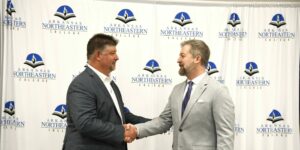UPGRADING YOUR LASER CUTTING EQUIPMENT WITH NEW TECHNOLOGY
Robert Kloczkowski of Rofin-Sinar examines how to replace fast axial flow resonators with new generation, high performance diffusion-cooled units, a proven strategy for older cutting machines.
Posted: March 12, 2010
Laser upgrade programs have been shown to be a proven strategy for older cutting machines where fast axial flow resonators are replaced with the new generation, high performance diffusion-cooled units. Results demonstrate outstanding performance improvements in piercing times, cutting speeds and cutting capacity. Maintenance and operating expenses are significantly reduced, producing financial benefits of excellent ROI and short payback periods.
In the past, sheet metal fabrication companies acquired new laser cutting equipment requiring large capital outlay to increase laser performance and/or capacity in their shops. Today, a large number of existing laser machines are in excellent working condition, but are limited by aging resonators. A high power diffusion-cooled resonator upgrade represents viable solution for fabrication companies seeking to improve their laser processing departments.
CRITERIA FOR A DIFFUSION-COOLED RESONATOR UPGRADE
Diffusion-cooled resonator upgrades should not be implemented unless several criteria are examined and satisfied, otherwise the capital expenditure is not warranted. The benefits of diffusion-cooled resonator technology can not be achieved if the machine or the application limits performance which in turn affects financial considerations.
First, machine considerations represent one of the most important factors, because performance is directly related to the equipment design, construction and condition. The machine design and construction should exhibit a well-built frame, drives and cutting tables capable of long term production demands. Moving optic designs that utilize dual cutting tables are recommended, because of their fast material transfer capability.
Laser/punch combo machines also warrant consideration, because of their dual functionality and high replacement costs. Finally, machines that incorporate costly features such as material handling systems, rotary cutting, and elaborate foundations are good candidates because of their high replacement costs. Conversely, light-duty, inexpensive laser cutting machines are poor candidates and should be avoided.
Second, application considerations represent another crucial factor, because the machine as well as diffusion-cooled resonator needs to comply with material processing limits of the application. In other words, the machine drive speeds and the maximum material cutting speeds need to correspond to truly take advantage of a diffusion-cooled resonator upgrade.
For example, if an application consists of oxygen cutting a large volume of 10 ga through 1 in steel plate, then upgrading a ball screw machine with a 4000 watt diffusion-cooled resonator is advisable. However, if the application involves nitrogen cutting a large volume of 16 ga stainless steel, then the ball screw drives would inhibit the potential performance of the 4000 watt diffusion-cooled resonator. The upgrade would not be recommended, because ball screw drives would limit cutting speeds to less than 400 ipm, whereas the 4000 watt diffusion-cooled resonator would be capable of supporting cutting speeds over 600 ipm.
In another example, a linear drive machine equipped with an aging 2000 watt resonator is dramatically limited in nitrogen cutting of light gauge applications. A 2500 watt or 4000 watt diffusion-cooled resonator upgrade of the linear drive machine would increase cutting speeds 100 percent to 200 percent.
Third, financial considerations represent a final factor. ROI and payback period dictates the use of capital. If the payback period is under two years, then most companies will benefit from a good return on their investment. The warranty coverage of most upgrade programs insures there will be not hidden costs. If the machine and application criteria are met, then the upgrade will produce the improved production, reliability and lower operational costs. Rule of thumb, if the laser cutting machine operates 4,000 hours annually or more than the payback period will be well under two years.
FAST AXIAL FLOW VERSUS DIFFUSIONED-COOLED RESONATORS
It is important to understand the dramatic differences between the 25-year-old fast axial flow technology and the new generation diffusion-cooled technology. First, the old technology will be examined.
Figure 1 displays a typical fast axial flow CO2 resonator with glassware and optics. Note that this type of resonator circulates a mixture of nitrogen, carbon dioxide and helium at high speed through glassware where it is excited by high voltage direct current or radio frequency. The laser beam is generated in the glassware, and it is intensified as it reflects back and forth between traditional internal optics. Approximately 50 percent of the laser beam exits the cavity via an output coupler that acts like a two-way mirror. It allows a portion of the beam to exit for cutting while reflecting a percentage of the beam to maintain the lasing process. The glassware and optics represent consumable components that require replacement after 5,000 to 20,000 hours of operation, depending on design.
Figure 2 shows the blower or turbine that drives the laser gas mixture through the gas circuit including heat exchangers to insure an optimum operating temperature of 70 deg F. A vacuum pump operates constantly to maintain a partial vacuum within the system to facilitate the efficiency of gas flow. As a result, laser gas consumption is usually 10 to 30 liters per hour, because the vacuum pump removes laser gas during its operation as it pumps down to maintain the partial vacuum. Typically, the blower or turbine requires replacement every 10,000 to 20,000 hours of usage.
Fast axial flow resonators have been used on laser cutting and welding machines for over 25 years and are still widely used today on new machines. The complex design produces a good quality laser beam and consistent performance, but exhibits high laser gas consumption, requires frequent planned maintenance and needs major component replacement in the long term.
Figure 3 depicts a diffusion-cooled slab resonator with its revolutionary design and beam generation process. Rather than circulate the laser gas mixture to accomplish proper cooling, the laser gas mixture is static. Cooling water is circulated through the slab electrodes thereby extracting heat directly from the excitation cavity.
The laser beam is generated in the .060 in gap excitation cavity between the slab electrodes where radio frequency is used to excite the gas. The asymmetric parabolic mirrors at each end of the slab electrodes intensify the laser beam by reflecting it back and forth across the surface of the electrodes. The laser beam exits the cavity where the shorter parabolic mirror allows it to pass through a diamond window and beam shaping optics.
Since the slab electrodes and parabolic mirrors are sealed in a chamber, periodic maintenance and long term repair is greatly minimized. In fact, the only major replacement component is the RF tube that has a life expectancy of greater than 15,000 hours.
Figure 4 represents a comparison chart of design and operational differences between 4000 watt resonators. The 4000 watt diffusion-cooled resonator possesses significant advantages over a traditional 4000 watt fast axial flow design.
There are major differences in beam quality between the technologies. The diffusion-cooled design produces a TEM00 mode which can be described a pure Gaussian Power Distribution Curve. As a result, it achieves the highest power density in the industry when the beam is focused for cutting. In comparison, a fast axial flow resonator typically produces a TEM01* or TEM01 mode which can be described as a Donut Mode Power Distribution Curve. Consequently, power densities are lower when the laser beam is focused.
This factor is crucial in performance considerations such as cutting speeds and piercing times. Figure 5 demonstrates the different laser beam characteristics. Note that a diffusion-cooled resonator produces a nearly perfect beam quality, while traditional fast axial flow resonators produce lower quality laser beams.
A LASER UPGRADE PROGRAM: A COMPLETE MACHINE RENOVATION
In the past, laser cutting and welding machines were retrofitted with identical resonators when a replacement unit was warranted due to breakdown or failure. This type of retrofit was a basic resonator swap out and did not include other components.
A laser upgrade program should involve a new approach; namely, a thorough reconditioning of a laser cutting machine in which most components are replaced except for the machine frame, cutting tables and drives. New technology components should replace the old ones, so the upgrade project actually converts the laser cutting machine to ?state of the art? technology, including resonators, stand and power supply cabinets, chiller, beam delivery purge gas filter/dryer system with distributive purge gas lines, back reflection protection, collimator and beam delivery optics, a non-contact laser cutting head, high speed tracking electronics for the laser cutting head, PC control where applicable, and software and parameter upgrades.
The following photos depict a typical laser upgrade program. In this example, a Cincinnati CL707 linear drive machine has been upgraded with new components and a diffusion-cooled 4000 watt slab resonator. Figure 6 shows a diffusion-cooled 4000 watt resonator and power supply cabinet mounted on the Cincinnati CL707 machine. The resonator stand facilitates beam delivery interface, because the diffusion-cooled resonator possesses a smaller size then the old resonator.
Since the new diffusion-cooled resonator required larger chiller specifications, a new chiller was provided in the upgrade project, as well as an advanced beam delivery purge gas filter/dryer system. These components are crucial to optimum performance of the high power diffusion-cooled resonator and upgraded beam delivery optics. The chiller provides ample cooling for the resonator electrodes, internal and external optics.
The beam delivery purge gas filter/dryer system converts regular compressed shop air to a high purity shielding and purge gas for use in the beam delivery system. Multiple filtering and treatment stages produce clean, dry compressed air for the beam delivery system. Specifications for the purified air meet or exceed -100 deg F dew point; .003 ppm @ 70 deg F oil/water particles and .01 micron dirt particles. Figure 7 displays the chiller and beam delivery purge gas filter/dryer system. Distributive purge gas lines are installed to deliver the purge gas uniformly throughout the beam delivery system.
The beam delivery system of the machine is also converted in the laser upgrade project because the beam quality and power levels of new resonator technology mandates superior beam delivery optics. Direct water-cooled ATFR back reflection protection, collimator, and X and Y-axis optics are installed for the reliable transmission of the laser beam from the resonator to the laser cutting head. A new non-contact laser cutting head is also retrofitted to maximize performance of the machine in most cases. Figure 8 shows the upgraded beam delivery components.
Sometimes additional upgrade work is performed over and above the typical original scope of work. The following examples represent application related improvements:
(1) Rapid pierce hardware and software that enhances the processing of thick plate
(2) Digital focus adjustment display
By retrofitting the additional components, the operation of laser cutting machines can be enhanced. Rapid piercing of thick plate will significantly reduce pierce times. The digital focus adjustment display will help operators to quickly and easily adjust focal position within +.001 in increments, thereby compensating for lack of an auto focus feature. Figure 9 reveals the additional upgrades.
Often the existing control hardware and software is sufficient, so only the power tables and cutting parameters are updated in the existing control and software. In other cases, a new PC control and software are installed to upgrade the machine. Figure 10 depicts a new PC control and software upgrade on a Cincinnati CL707 machine.
The revision of cutting parameters from the original resonator to the new diffusion-cooled resonator is a final procedure prior to release to production.
CASE STUDY: ANDERSEN INDUSTRIES
Andersen Industries (Adelanto, CA) is a precision custom fabricator, established in 1969, that has steadily grown to become one of the premiere precision job shops servicing the Southwest market. The company processes a variety of materials including steel, stainless steel and aluminum as well as a vast range of material thicknesses from .020 in through 1.000 in.
In 1997 Andersen acquired two Cincinnati CL707 6×12 2000 watt CO2 laser cutting machines that featured high speed linear drives capable of rapid traverse speeds of 8000 ipm, as well as +.001 in positioning accuracy. One unit was a right hand configuration and the other was a left hand configuration to create a laser work cell.
In early 2006, the company decided to replace the units with new 4000 watt machines to remain competitive in the market. During their research, Andersen learned of the laser upgrade program and, after evaluation, selected a diffusion-cooled 4000 watt laser upgrade. Figures 1-10 represent the Andersen Industries project.
Their diffusion-cooled 4000 watt machine performance demonstrated dramatic results in all material thicknesses. Cutting thin materials with nitrogen assist gas produced cutting speeds that exceeded most new machine performance specifications that were equipped with 4000 watt fast axial flow resonators.
For example, cutting speeds up to 800 ipm were achieved when cutting light gauge stainless steel and processing thick plate up to 1 in steel was accomplished. Production runs confirmed the processing advantages of the diffusion-cooled TEM00 beam quality. The high speed linear drive motors of the CL707 machines were able to utilize the cutting capabilities of the resonator. Figure 11 documents Andersen?s dramatic performance improvement, from 2000 to 3300 to 4000 watts.
Figure 12 depicts a 16 ga stainless steel part that is frequently processed in large lot sizes. The part consists of long straight line cuts, intricate tabs and slots, large and small internal geometries. In processing the part, four pierces and 122.28 in of cutting is performed. Prior to the upgrade, the CL707 2000 watt machine processed the part in 40 seconds. The upgraded CL707 dramatically reduced the total processing time to less than 15 seconds, a 62 percent reduction in part processing time.
Depending on gauge, Andersen Industries light gauge cutting speeds jumped by an average of 100 percent when using nitrogen assist gas. Figure 13 demonstrates the equally dramatic improvement in steel plate processing capability. As a result, the CL707 machine cutting capacities were increased to 1 in steel.
The CL707 machines with the diffusion-cooled resonators achieved performance levels that met or exceeded new machine models. In addition, considerable downtime was eliminated from the operation because less maintenance and repair was encountered after the upgrades.
Profitability data was attributed to increased performance, capacity and decreased operating/maintenance costs and was documented. Figure 14 summarizes the annual savings and profitability improvements of the Andersen Industries laser upgrade project. The simple project payback period was calculated to be 1.4 years.
CONCLUSION
The laser upgrade concept has undergone an evolution from simple resonator replacements to the comprehensive machine renovations similar to the aforementioned case studies. The popularity of laser upgrades projects is expected to increase as the large inventory of laser cutting machines continues to age.
Laser service companies are performing upgrade projects as the concept becomes more widely accepted by the industry. For example, we have implemented 70 successful laser upgrade projects during the past few years. With the average ROI payback period of less than two years, it is expected that the concept will continue to be popular.
Companies considering an upgrade project should implement the proper approach for their application. First, they should determine that the equipment is structurally sound and capable of many more years of reliable operation. Second, they should acknowledge that the laser upgrade concept is a viable method of obtaining new technology and a good alternative to purchasing new equipment. Third, they should evaluate their material processing application and understand that an upgraded machine could meet or exceed the performance levels of a new machine.
Other considerations include: 1) evaluate the technology options to select the most cost effective solution for their production needs; 2) responsibility for in-house preparation and coordination to insure a successful upgrade schedule, and 3) measure the performance and results of the project.
Upgrade projects are not recommended for all laser cutting machines and application because ROI and payback periods may be excessive for some operations. Also, some applications may limit feasibility:
1) equipment with extensive repairs and reconditioning requirements;
2) applications requiring special options that cannot be retrofitted to existing machines, and
3) control and software incompatibility.
– – – – – – – – – – – – – – – – – – – – – – – – – – – – – – – – – – – – – – – – –
Robert Kloczkowski is a fabrication industry specialist with Rofin-Sinar, Inc., 482 Lakewood Farms Drive, Loveland, OH 45140, 513-677-3310, Fax: 734-454-0815, b.kloczkowski@rofin-inc.com, www.rofin-inc.com.










